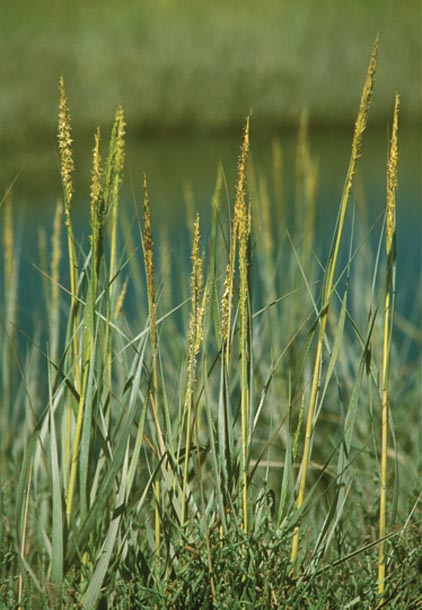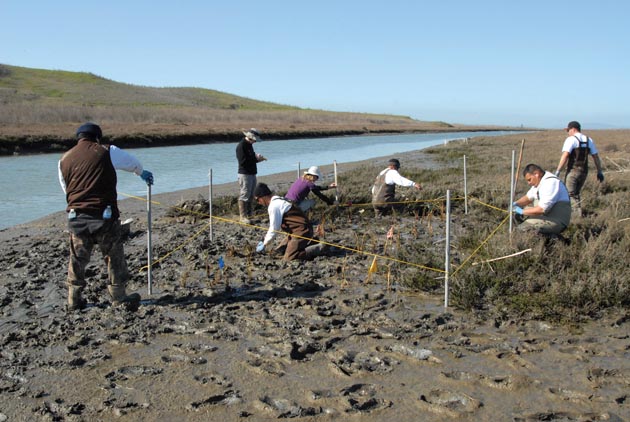On a crisp day in early January, 10 workers and two biologists pulled sleds loaded with young grindelia and Spartina foliosa through tangled pickleweed to the edge of the Alameda Flood Control Channel. The marsh seemed to be asleep, everything a muted brown and a bit dry for lack of rain. But in the midst of this hibernation, little neon-colored flags marked the places where thousands of plants would soon have a new start, the next stage of a battle waged mostly out of sight on the edges of sleepy marshes around the Bay Area.
Until a few years ago, the Alameda FCC was inundated by an invasive form of spartina, or cordgrass. Originally brought from the East Coast in the 1970s by the Army Corps of Engineers for a channel bank restoration project, Spartina alterniflora hybridized with the native cordgrass, Spartina foliosa, and took over. One of the biologists on site, a San Francisco State graduate student named Whitney Thornton, remembered the plants growing thick across the channel.
“When I started working, it was high over my head and it filled this whole area,” she said, walking from a trail toward the waterfront, gesturing toward the mudflats.
Today, after 13 years of work by the Invasive Spartina Project and its partners to eliminate the invasive hybrid, the team is now into the rebuilding phase of its long-term plan, replanting the area with native cordgrass in hopes that it will reclaim its former territory. That sounds simple enough. But the complications have been manifold and solutions have required the same kind of ingenuity and flexibility that went into the original, and continuing, eradication effort.

The ISP was established in 2000 with the goal of eradicating the non-native plants and restoring the wetlands. Having tried various forms of mechanical removal and found them unworkable, the group spent years painstakingly spraying herbicide on the invasive cordgrass, and using helicopters to cover the larger and less accessible areas. Persistence paid off, and from 2005 to 2010, they reported great success curbing the spread and eliminating large patches of the plant. But they found that they couldn’t just come back in and immediately replant natives. Planting Spartina foliosa where there are still even a few hybrids can trigger a new swarm and set the whole effort back.
This need for a delay in replanting has compounded the challenge of helping the endangered clapper rail, which, although it is negatively affected by the clogged marsh channels, has come to use the dense stands of invasive cordgrass as cover from predators. If the clapper rails don’t get new habitat before the invasive spartina is removed — or at least soon after — then the rails could be exposed to increased predation. “We have to be as thoughtful and creative as we can to transition these sites,” says Katy Zaremba an ISP field biologist. At some sites, the ISP has developed islands as clapper rail refuges during high tides. At others, they have placed temporary artificial floating nesting islands while they eliminate the invasive plants.

Even the growing of native plants to replace the hybrids is not simple. That challenge has fallen to the Watershed Nursery in Point Richmond, where a precise operation has been set up to make sure the replanting succeeds. To deal with concerns that hybrids might invade the nursery stock, the “parent” Spartina foliosa specimens were gleaned from marsh plants that could be genetically tested at UCLA. To ensure that the plants used would be appropriate to each site and that there would be genetic diversity, multiple samples were taken from healthy native plants from the North, South, and Central Bay areas. Then the staff at the nursery had to develop methods for propagating plants in quantity (the project estimates it will still need more than 200,000 plants before it is done) and ensure they would survive in the field. Gumplant (or grindelia), another native salt marsh plant that is being planted along with the native spartina, is being raised in different container sizes to see how that impacts height and fullness, and salt is added to cordgrass water in varying amounts to see if salt-hardening significantly improves subsequent survival in the field.
In December and January — the replanting time before clapper rail breeding season in February — the plants are removed from their beds at the nursery by hand and shipped off to the various replanting sites. About 20 to 25 percent of the plugs in any given spartina batch remain with the nursery so they can repropagate for the next batch. The nursery also collects seeds for future beds and replantings, storing them in 50-pound sacks inside a dark shed. Using seeds rather than samples from the field has less impact on the habitat and, because each one is unique, using seeds can also translate to even more diversity at the replanting sites.
The experimentation continues out in the field, as the teams determine the preferred elevations for the different strains, as well as how to protect the new plants from foraging herbivores. During the first year, plants were completely wiped out by hungry geese at two sites. Now, workers set up PVC and rope “cages” around many of the plants to protect them until they are large enough to thrive on their own. The ISP is also varying plant height, parent sources, and densities in each grid to see which combinations have the highest survival rates in which areas.
As both the original introduction site of the invasive spartina and one of the first to be replanted, the Alameda FCC is a poster child of sorts for the ISP. The new plants have been extremely successful here, with a 72 percent survival rate after the first year of planting. Along the water’s edge the replanted native spartina is starting to fill out plots where it was planted two years ago. At the third and final planting location of the day, graduate student Thornton tugged a sled of cordgrass through the dense pickleweed. “It has gone very fast,” Thornton said. “We’re going to wrap when we finish this area.”
The assembly line of project workers dug and planted, dug and planted. “Chiquitos, chiquitos,” one of the crewmembers said to a bright green spartina as he lovingly patted mud around its roots.



-300x190.jpg)